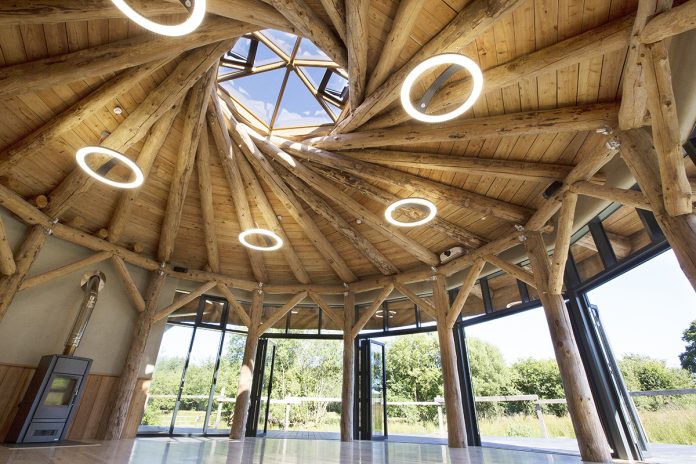Mark McKenna MBE, Co-Founder/CEO of Down to Earth, tells us about new ways to tackle social and environmental challenges at the same time since
The award-winning group of social enterprises, Down to Earth, has been exploring new ways of tackling social and environmental challenges at the same time since 2005.
Working with some of the most vulnerable and disadvantaged communities in South Wales, UK, Down to Earth has built up the evidence base and demonstrated the viability of communities delivering large-scale, nature-centred infrastructure – from houses to healthcare facilities – and life-changing healthcare and education programmes through that approach.
Delivering healthcare and education through building homes and hospitals
Imagine social rent homes designed and built by the community – using only natural materials and nature-centred design – and through that process, improving mental health and providing qualifications for everyone involved.
Imagine the NHS delivering stroke, brain injury, cardiology and low-secure mental health services through patients and staff designing and building flagship hospital buildings with natural materials (and surrounding grounds) – and through that process, reducing recovery times and improving the well- being of the NHS workforce.
Down to Earth has been working closely with health boards across South Wales to deliver these schemes. Critically, they’ve appointed academic partners to research and open-source to publish the impact.
Evidence-based and published research
Working closely with Swansea University, Down to Earth has two peer-reviewed papers on their work published in the Journal of Mental Health. Led by Professor Jason Davies – part-time Swansea University Psychology Department and part-time Swansea Bay University Health Board – the research base for Down to Earth’s work covers a ten-year period.
“ Down to Earth demonstrated that their outdoor healthcare programme Reconnect yielded a £9.14 return for each £1 invested.”
The first paper – Using engagement in sustainable construction to improve mental health and social connection in disadvantaged and hard to reach groups: a new green care approach – evidences how their unique approach is as effective at tackling depression and anxiety as anti-depressants.
Seeing is believing: Case studies
Since June 2020, Down to Earth has partnered with Cardiff and Vale Health Charity and Cardiff and Vale University Health Board to co-design and deliver green infrastructure to facilitate rehabilitation and recovery programs for more than 1,600 inpatients and outpatients, NHS staff and community group members. Based at Wales’ second largest hospital, University Hospital Llandough, the 14-acre site – Our Health Meadow – will continue to be developed and managed sustainably, hosting clinically endorsed healthcare programs for conditions like acquired and traumatic brain injury, congenital heart disease, spinal cord injuries, neurorehabilitation, and adult mental health. You can find out more about this case study here.
Welsh Government Innovative Housing Programme – Social rent housing
Working with a range of community groups – from asylum seekers through to long-term unemployed – as well as health board groups, Down to Earth designed and built six social rent homes for people most in need of housing in Swansea, South Wales. Using only Welsh timber and natural materials, these super-insulated, solar-centred homes were entirely created through a healthcare and education-centred approach. You can find out more about this case study here.
Nature-centred design
To enable people and nature to thrive together, Down to Earth only builds with natural materials, including local timber, wood-fibre insulation and clay plasters, creating fully vapour permeable (‘breathable’), super-insulated properties with low-embodied carbon and high biodegradability. Alongside ensuring people from vulnerable backgrounds can create all their buildings, their solar-centred buildings are south-facing, integrating roof-mounted solar arrays, natural lighting, natural ventilation and green roof systems.
What’s next for Down to Earth?
With a robust evidence base, Down to Earth is now scaling the approach into the design and build of entire schools, hospitals, and large-scale housing schemes. Imagine if all schools, homes and hospitals were designed and built through this approach. The benefit to people and nature would be truly transformational.
If you’d like to find out more, get in touch with Down to Earth via their webpage: www.downtoearthproject.org.uk or email info@downtoearthproject.org.uk
The second paper – the emoji current mood and experience scale: the development and initial validation of an ultra-brief, literacy independent measure of psychological health – focuses on Down to Earth’s development of a new, inclusive mental health measure which has equivalence with the PHQ5 and Edinburgh Warwick Scale using emojis. The measure was developed to enable even the most marginalised and vulnerable people to be supported in accurately measuring their mental health.
This measure is being digitised currently and Down to Earth’s new app – myemoji – will be available for use shortly. If you’d like to know more, see the end of the article for contact details.
Clinical research trials with NHS staff
The published papers demonstrate the impact on the patients and communities Down to Earth has worked with. However, their current clinical research trials with Swansea University focus on the well-being impact of the NHS staff accompanying the patients on their programmes. The clinical research trials will finish in autumn 2023, and the results will be published in 2024.
Social return on investment
Using SVUK Social Return on Investment analysis, Down to Earth demonstrated that their outdoor healthcare programme Reconnect yielded a £9.14 return for each £1 invested. Partnering with Natural Resources Wales and working with two health boards, the collaboration generated amplified social benefits (e.g., anxiety and depression relief; enhanced physical activity and mobility; social connections), environmental benefits (invasive species control; improved public woodland access), and economic savings (NHS, Department of Work and Pensions, and HMRC).
Thank you to the National Lottery Community Fund for supporting our research and the publication of this paper.















